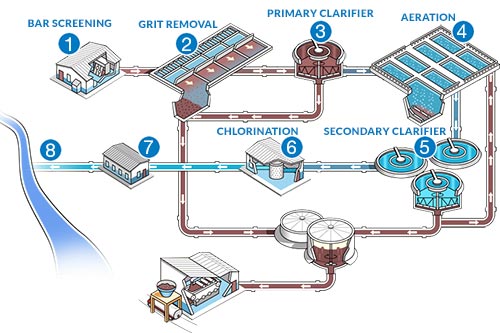Improving Wastewater Treatment with Green Innovations
Improving Wastewater Treatment with Green Innovations
Blog Article
Comprehending Wastewater Therapy Processes and Their Environmental Influence
The details of wastewater therapy procedures play an essential function in mitigating environmental challenges associated with water pollution. Each phase, from initial to innovative treatments, is developed to deal with specific contaminants, inevitably guarding both public health and wellness and water environments.
Summary of Wastewater Treatment
Just how is wastewater changed into a safe source for the atmosphere? Wastewater treatment is a crucial process made to eliminate contaminants from used water, therefore securing public health and protecting ecological communities. This process begins with the collection of wastewater from household, industrial, and commercial resources, which is then routed to treatment centers.
At these facilities, different physical, chemical, and biological techniques are used to treat the wastewater. Consequently, organic treatments, such as triggered sludge procedures, make use of bacteria to damage down natural issue.
The treated effluent can be securely discharged into natural water bodies or recycled for watering and industrial functions, advertising source preservation. Additionally, the treatment procedure creates biosolids, which can be repurposed as fertilizers or soil modifications, further enhancing sustainability.
Stages of Therapy Processes
The wastewater treatment process typically contains 3 main stages: preliminary, main, and secondary treatment. Each stage offers a distinctive duty in decreasing the contaminant tons and making certain the effluent meets environmental requirements prior to discharge.

The key therapy phase concentrates on the physical splitting up of put on hold solids from the wastewater. With sedimentation, much heavier bits work out at the bottom of sedimentation storage tanks, developing sludge, while lighter materials, such as oils and greases, float to the surface area and are skimmed. This procedure substantially minimizes the organic and inorganic tons in the wastewater.
Second therapy is a biological procedure aimed at more lowering the concentration of organic issue. This stage is essential for attaining the required biochemical oxygen need (BODY) decrease, eventually leading to cleaner effluent ready for discharge or additional treatment.

Advanced Treatment Technologies
Following the additional therapy procedures, advanced treatment modern technologies play a crucial function in more boosting the top quality of dealt with wastewater. These modern technologies are made to remove recurring contaminants that are not effectively eliminated during primary and additional therapies, guaranteeing the effluent satisfies stringent regulative criteria.
Amongst the widely used innovative treatment techniques are membrane layer purification, reverse osmosis, and advanced oxidation procedures. Membrane layer filtration, including microfiltration and ultrafiltration, works in dividing great particles, microorganisms, and colloids from the water (Wastewater). Reverse osmosis uses semi-permeable membrane layers to get rid of dissolved solids, leading to high-quality water ideal for different applications
Advanced oxidation procedures (AOPs) use solid oxidants to degrade organic pollutants, consisting of pharmaceuticals and personal treatment items that are immune to standard therapy. These approaches boost the biodegradability of intricate substances, promoting their removal.
One more considerable innovation is using organic nutrient removal processes, which particularly target nitrogen and phosphorus, stopping eutrophication in getting water bodies. Generally, advanced therapy modern technologies are essential for achieving greater degrees of filtration, advertising water reuse, and securing public health and wellness while attending to the difficulties linked with wastewater monitoring.
Ecological Advantages of Treatment
Numerous environmental advantages develop from efficient wastewater treatment processes that add to ecosystem health and sustainability. Primarily, these procedures dramatically minimize the release of harmful toxins right into natural water bodies, which aids keep aquatic ecosystems. By getting rid of contaminants such as hefty metals, nutrients, and pathogens, dealt with wastewater alleviates the risk of waterborne conditions and advertises biodiversity in marine settings.
Additionally, wastewater treatment centers commonly employ innovative innovations that enable water recycling and reuse. This technique not just conserves fresh water resources yet likewise reduces the need on natural water products. Enhanced nutrient elimination from wastewater can also protect against eutrophication, a procedure that leads to algal flowers and subsequent oxygen exhaustion in aquatic systems.
Furthermore, effective treatment procedures can reduce greenhouse gas discharges, particularly methane and laughing gas, which are typically launched during unattended wastewater decay. By recording and utilizing biogas from read review anaerobic digesters, centers can transform waste into renewable power, thereby adding to a decrease in fossil browse this site gas dependency.
Difficulties and Future Fads
While the environmental benefits of wastewater therapy are clear, numerous difficulties continue that prevent optimum outcomes in this field. One significant concern is aging infrastructure, which usually brings about inefficiencies and boosted functional prices - Wastewater. Many treatment plants were created years earlier, and their capacities do not align with modern demands, that include more stringent governing criteria and greater quantities of wastewater due to urbanization

Looking in advance, there is an expanding emphasis on source healing and circular economic situation principles within wastewater treatment. Advancements such as anaerobic digestion, which can generate biogas, and progressed filtering technologies useful content are obtaining traction. These approaches not just enhance therapy efficiency yet likewise advertise sustainability.
Eventually, addressing these obstacles needs collaboration among stakeholders, financial investment in innovation, and a dedication to continuous study. By accepting these fads, the wastewater treatment market can develop to fulfill the demands of a transforming environment and society.
Verdict
To conclude, wastewater therapy processes play a crucial role in improving ecological quality and public wellness. The multi-stage therapy framework, combined with innovative innovations, properly mitigates contamination and advertises lasting water management. By attending to residual pollutants and lessening nutrient runoff, these processes add to the conservation of aquatic environments and the decrease of greenhouse gas exhausts. Continued developments and adaptations in treatment techniques will be crucial for conquering arising challenges and ensuring the sustainability of natural resources (Wastewater).
Report this page